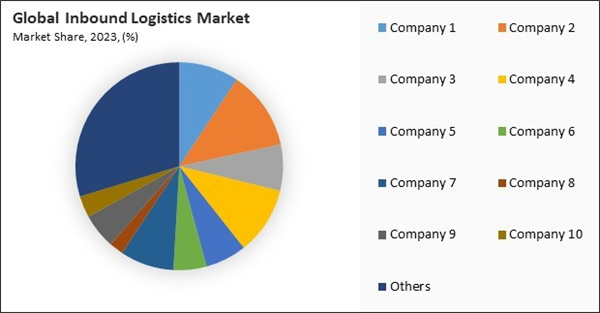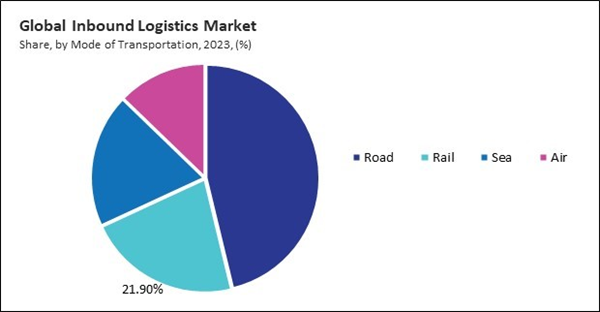The Global Inbound Logistics Market size is expected to reach $2.54 trillion by 2031, rising at a market growth of 7.4% CAGR during the forecast period.
The Asia Pacific segment recorded 38% revenue share in the market in 2023. This can be attributed to the region’s dynamic and rapidly expanding manufacturing and retail sectors. Asia Pacific, especially countries like China, India, Japan, and South Korea, are major hubs for production and distribution. The rise in e-commerce and the increased need for raw materials and components in manufacturing have fuelled the demand for inbound logistics.
Due to economic globalization, global trade has been accelerating, increasing the transportation of goods across borders. This demand for global trade is pushing the need for more robust and efficient inbound logistics systems that can handle the complexities of international supply chains. Companies are expanding their operations and sourcing raw materials worldwide, significantly impacting the logistics industry. Thus, rising global trade and increasing cross-border transportation drive the market's growth.
Additionally, the logistics industry is rapidly adopting digital technologies, reshaping these logistics operations. Technologies like the Internet of Things (IoT), Artificial Intelligence (AI), Blockchain, and advanced data analytics drive this digital transformation. These logistics companies are leveraging these technologies to improve inventory management, optimize transportation routes, and enhance real-time tracking of goods, leading to greater efficiency. In conclusion, the growing adoption of digitalization and advanced technologies in logistics operations is driving the market's growth.
However, Transportation costs, particularly fuel-related, are among the most significant expenses in inbound logistics. Fuel price volatility is a recurring issue, so logistics providers face difficulties in predicting and managing transportation costs. Fuel prices fluctuate, impacting the overall cost structure and making it challenging to offer competitive pricing while maintaining profit margins. These fluctuations can also complicate long-term contracts between companies and logistics providers. Hence, high transportation costs and fuel price volatility hinder the market's growth.
The leading players in the market are competing with diverse innovative offerings to remain competitive in the market. The above illustration shows the percentage of revenue shared by some of the leading companies in the market. The leading players of the market are adopting various strategies in order to cater demand coming from the different industries. The key developmental strategies in the market are Acquisitions, and Partnerships & Collaborations.
The Asia Pacific segment recorded 38% revenue share in the market in 2023. This can be attributed to the region’s dynamic and rapidly expanding manufacturing and retail sectors. Asia Pacific, especially countries like China, India, Japan, and South Korea, are major hubs for production and distribution. The rise in e-commerce and the increased need for raw materials and components in manufacturing have fuelled the demand for inbound logistics.
Due to economic globalization, global trade has been accelerating, increasing the transportation of goods across borders. This demand for global trade is pushing the need for more robust and efficient inbound logistics systems that can handle the complexities of international supply chains. Companies are expanding their operations and sourcing raw materials worldwide, significantly impacting the logistics industry. Thus, rising global trade and increasing cross-border transportation drive the market's growth.
Additionally, the logistics industry is rapidly adopting digital technologies, reshaping these logistics operations. Technologies like the Internet of Things (IoT), Artificial Intelligence (AI), Blockchain, and advanced data analytics drive this digital transformation. These logistics companies are leveraging these technologies to improve inventory management, optimize transportation routes, and enhance real-time tracking of goods, leading to greater efficiency. In conclusion, the growing adoption of digitalization and advanced technologies in logistics operations is driving the market's growth.
However, Transportation costs, particularly fuel-related, are among the most significant expenses in inbound logistics. Fuel price volatility is a recurring issue, so logistics providers face difficulties in predicting and managing transportation costs. Fuel prices fluctuate, impacting the overall cost structure and making it challenging to offer competitive pricing while maintaining profit margins. These fluctuations can also complicate long-term contracts between companies and logistics providers. Hence, high transportation costs and fuel price volatility hinder the market's growth.
The leading players in the market are competing with diverse innovative offerings to remain competitive in the market. The above illustration shows the percentage of revenue shared by some of the leading companies in the market. The leading players of the market are adopting various strategies in order to cater demand coming from the different industries. The key developmental strategies in the market are Acquisitions, and Partnerships & Collaborations.
Driving and Restraining Factors
Drivers
- Rising Global Trade And Increasing Cross-Border Transportation
- Growing Adoption Of Digitalization And Advanced Technologies In Logistics Operations
- Expansion Of The E-Commerce Industry Worldwide
Restraints
- High Transportation Costs And Fuel Price Volatility Hindering Profit Margins
- Rising Cybersecurity Threats And Data Breaches In Digital Logistics
Opportunities
- Increasing Demand For Sustainable And Green Logistics Solutions
- Development Of Smart Warehousing And Automation Technologies
Challenges
- Lack Of Real-Time Visibility And End-To-End Supply Chain Transparency
- Rising Fuel Costs And Transportation Price Volatility
Service Outlook
Based on service, the market is characterized into transportation, warehousing & storage, inventory management, procurement services, and others. The warehousing & storage segment attained 22% revenue share in the market in 2023. This growth is driven by the increasing need for efficient inventory management and the rising demand for temperature-controlled storage solutions across various industries such as food & beverage, pharmaceuticals, and e-commerce. Advanced warehouse management systems (WMS) and automation technologies are further enhancing operational efficiency, reducing costs, and improving accuracy in inventory handling.End Use Outlook
By end use, the market is divided into retail & e-commerce, manufacturing, automotive, pharmaceuticals, food and beverages, electronics, and others. The manufacturing segment attained 22% revenue share in the market in 2023. Manufacturing relies heavily on the timely arrival of raw materials and components to keep production lines running smoothly. The complexity and scale of global supply chains in automotive, electronics, and machinery industries make effective inbound logistics essential for maintaining operational efficiency and minimizing production downtime.Mode of Transportation Outlook
On the basis of mode of transport, the market is classified into road, rail, air, and sea. The air segment recorded 22% revenue share in the market in 2023. Although more expensive than road or rail, air transport is ideal for high-priority shipments, such as electronics, pharmaceuticals, and perishable goods, that require swift delivery. The growing demand for time-sensitive goods in industries like healthcare and retail has driven the need for air logistics services.Regional Outlook
Region-wise, the market is analyzed across North America, Europe, Asia Pacific, and LAMEA. The North America segment witnessed 30% revenue share in the market in 2023. North America, particularly the United States and Canada, has a well-developed logistics infrastructure supported by a strong manufacturing base and a growing e-commerce sector. The region’s demand for efficient and scalable inbound logistics solutions has increased due to the expansion of the automotive, retail, and pharmaceutical industries.List of Key Companies Profiled
- DSV A/S
- Kuehne + Nagel International AG (Kuehne Holding AG)
- XPO, Inc.
- Deutsche Bahn AG (DB Schenker)
- FedEx Corporation
- C.H. Robinson Worldwide, Inc.
- A.P. Moller - Maersk A/S
- Burris Logistics
- Nippon Express Co., Ltd.
- Ryder System, Inc.
Market Report Segmentation
By Service
- Transportation
- Warehousing & Storage
- Inventory Management
- Procurement Services
- Other Service
By End Use
- Retail & e-commerce
- Manufacturing
- Automotive
- Food & beverage
- Electronics
- Pharmaceuticals
- Other End Use
By Mode of Transportation
- Road
- Rail
- Sea
- Air
By Geography
- North America
- US
- Canada
- Mexico
- Rest of North America
- Europe
- Germany
- UK
- France
- Russia
- Spain
- Italy
- Rest of Europe
- Asia Pacific
- China
- Japan
- India
- South Korea
- Singapore
- Malaysia
- Rest of Asia Pacific
- LAMEA
- Brazil
- Argentina
- UAE
- Saudi Arabia
- South Africa
- Nigeria
- Rest of LAMEA
Table of Contents
Chapter 1. Market Scope & Methodology
Chapter 2. Market at a Glance
Chapter 3. Market Overview
Chapter 4. Competition Analysis - Global
Chapter 5. Global Inbound Logistics Market by Service
Chapter 6. Global Inbound Logistics Market by End Use
Chapter 7. Global Inbound Logistics Market by Mode of Transportation
Chapter 8. Global Inbound Logistics Market by Region
Chapter 9. Company Profiles
Companies Mentioned
- DSV A/S
- Kuehne + Nagel International AG (Kuehne Holding AG)
- XPO, Inc.
- Deutsche Bahn AG (DB Schenker)
- FedEx Corporation
- C.H. Robinson Worldwide, Inc.
- A.P. Moller - Maersk A/S
- Burris Logistics
- Nippon Express Co., Ltd.
- Ryder System, Inc.
Methodology

LOADING...











